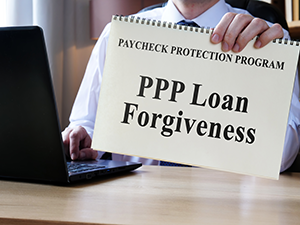Understanding your PPP Loan and Forgiveness Planning
 As with many of the recently passed coronavirus-related economic stimulus programs, regulations covering the Payroll Protection Program (PPP) – especially dealing with loan forgiveness – are still a work in progress.
As with many of the recently passed coronavirus-related economic stimulus programs, regulations covering the Payroll Protection Program (PPP) – especially dealing with loan forgiveness – are still a work in progress.
The main priority now for businesses receiving PPP loans is spending the money on allowable expenses within eight weeks of its receipt.
During that time, your business should maintain the same full-time equivalents as before, ensure employees received at least 75 percent of their wages and spend no more than 25 percent of the funds on non-payroll costs.
To help you manage your loan effectively, Boyer & Ritter partnered with Albin, Randall & Bennett CPAs (Portland, ME) to develop a workbook to assist businesses with navigating this uncertainty.
Used for planning purposes, users can input the loan amount, date funded, and known and projected allowable costs to arrive at a preliminary amount of loan forgiveness. The workbook will automatically apply reduction limitation rules, allow users to manipulate pay and hire dates, and forecast the forgivable portion.
We know that a lack of clear final regulations creates many unanswered questions, and all of us at Boyer and Ritter will continue to provide our clients with the latest information.
The following is what we know about the Payroll Protection Program as of today:
PPP loan expenditures: Allowable vs. forgivable
Allowable costs include payroll costs rent, mortgage interest and utilities – and must be spent by June 30, 2020.
Only allowable costs paid and incurred within the eight-week covered period are qualified for forgiveness.
The Small Business Administration (SBA) further specified that at least 75 percent of the allowable costs paid from the loan proceeds go toward payroll costs. Additionally, nonpayroll costs (mortgage interest, rent, utilities, etc.) can make up no more than 25 percent of the amount forgiven.
Payroll Costs
Payroll costs include:
- Salary, wage, commission or similar compensation
- Cash tips or equivalent
- Vacation, parental, family, medical or sick leave
- Allowance for dismissal or separation
- Employer portion of:
- Group health care benefits, including insurance premiums
- Payment of any retirement benefit
- Payment of state or local tax assessed on compensation of employees
Payroll costs do not include
- Compensation of an individual employee in excess of an annual salary of $100,000, as prorated for the covered period
- People paid via a 1099
- Employer portion of FICA and FUTA
- Compensation for employees living outside the U.S.
- Any amounts paid to employees under the Emergency Family and Medical Leave Act (EFMLA) or Emergency Paid Sick Leave (EPSL). These amounts are paid via fully refundable tax credits on the employer’s quarterly 941s provided for in the Families First Coronavirus Response Act.
Additional limitations on forgiveness
The first limitation states an employer’s full-time equivalents (FTE) must remain, on average, equal to their FTEs during the period 2/15/2019 – 6/30/2019 or 1/1/2020 – 2/29/2020. An employer may select whichever period is more beneficial.
Second, an employer must demonstrate they maintained employee compensation on an individual basis during the eight-week covered period at 75 percent of the employee’s compensation for the most recent quarter before receiving the loan proceeds.
Moving forward
There are still many questions as yet unanswered, such as:
- Does rent include both real property and personal property?
- The definition of utilities includes “transportation” – what is that?
- Are there any recurring item exceptions to the “incurred and paid” concept for costs?
- What is the definition of a Full-Time Equivalent (FTE)?
- Does the “most recent full quarter” mean Q1 2020 for all employees? Or only those not furloughed in March? For the wage reduction test, is the Q1 2020 wage intended to be pro-rated to the eight-week equivalent?
- For the wage reduction test, how do you handle an employee who does not return for non COVID reasons?
- Do loan proceeds not spent on allowable costs need to be paid back immediately?
- In what order and to what amounts do you apply the various forgiveness reduction rules: 75/25; FTE; wage reductions?
- Is it tax-free income, or does the loan generate non-deductible expenses?
- Does floorplan interest count as “mortgage” interest or “other debt” interest?
Our hope is the final regulations issued by the SBA will answer these questions and many more.
The Boyer & Ritter team is keeping track of the latest information and guidance. We’re here to work with you and your company to ensure you get the full benefits provided by the CARES Act and any other changes made by federal or state governments during and after the coronavirus pandemic.
If you have questions regarding the workbook or related COVID-19 laws and regulations, please refer to the resources available at www.cpabr.com



